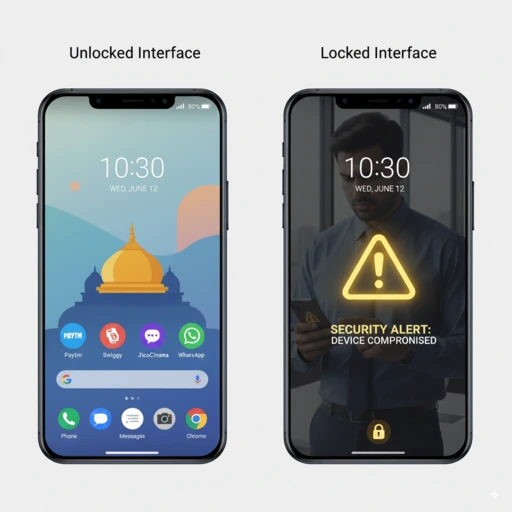You might be wondering about those reports flooding social media about the Reserve Bank of India allowing banks to remotely lock your smartphone if you default on EMI payments. Let’s break down what’s actually happening and what it means for everyday Indians like us.
Picture this: Rahul, a 28 year old working professional from Pune, just bought the latest iPhone on EMI. Two months later, he loses his job and struggles to pay his monthly instalments. Under RBI’s proposed rules, his lender could potentially lock his phone remotely until he clears his dues. Sounds scary, right? But there’s more to this story.
What RBI is Actually Proposing

The Reserve Bank of India is reportedly considering updates to its Fair Practices Code that would allow lenders to remotely lock smartphones purchased on credit if borrowers default on their EMI payments. This isn’t some sudden decision – it’s RBI’s response to a growing problem in India’s consumer electronics financing sector.
Here’s what makes this significant: over one-third of consumer electronics in India are now purchased on small loans, and with more than 1.16 billion mobile connections in our country, we’re talking about a massive market. Non-bank lenders account for about 85% of these consumer durable loans.
The proposal primarily targets small-ticket loans under ₹1 lakh, which covers most consumer smartphone financing.
The key safeguards being proposed include:
- Lenders must obtain explicit prior consent from borrowers before any locking mechanism is activated
- Strict prohibition on accessing personal data stored on locked devices
- The locking feature would only disable core device functions while preserving emergency access
- Borrowers must be fully informed about potential consequences when signing the loan agreement
Why This Rule is Being Considered
Let’s talk numbers. Loans under ₹1 lakh show some of the highest delinquency rates in India’s lending landscape. Recent data shows that loan defaults have surged to 3.6% in March 2025, up from 3.3% a year earlier, with Tier 3 towns and rural areas seeing delinquency rates of 4.2% and 4.1% respectively.
The problem is particularly acute among younger borrowers. Many Indians under 25 are taking small-ticket loans – often below ₹10,000 – without proper repayment plans or financial cushions. These borrowers often have little to no credit history and are attracted by easy EMI options for aspirational purchases like premium smartphones.
Think about it: unlike cars or homes, smartphones are small, portable assets that are difficult for lenders to physically repossess. This has created a recovery challenge for banks and NBFCs, especially when dealing with willful defaulters.
The Consumer Rights Debate

Consumer advocates are raising serious concerns about this proposal. Cashless Consumer, warns that “this practice weaponizes access to essential technology to enforce behavioral compliance, locking users out of livelihoods, education, and financial services until repayment”.
There is a point. In today’s India, smartphones aren’t just communication devices, they’re our gateway to digital payments, online education, work-from-home opportunities, healthcare consultations, and government services. Locking someone’s phone could potentially cut them off from essential services and livelihood opportunities.
The key concerns include:
- Impact on access to emergency services (though emergency calling would remain available)
- Disruption to work and education, especially for those dependent on digital platforms
- Potential for misuse by aggressive recovery agents
- Questions about digital inclusion and fairness
What This Means for Middle-Class India

Let’s get practical. If you’re someone like Priya, a 32-year-old marketing professional from Delhi who bought her Samsung Galaxy on EMI, this rule change could directly affect you. The proposed regulations would primarily target small-ticket loans under ₹1 lakh – exactly the category most middle-class Indians use for smartphone purchases.
For borrowers, this means:
- You’ll need to explicitly consent to any phone locking mechanism before taking the loan
- Your personal data will remain protected, lenders can only lock the device, not access your photos, messages or apps
- You’ll have clearer information about consequences of default upfront
- Emergency functions will remain accessible even if your phone is locked
For the lending industry:
Major consumer lenders like Bajaj Finance, DMI Finance, and Cholamandalam Finance could benefit from improved recovery rates. Better recovery could potentially mean these companies might offer credit to customers with weaker credit histories, expanding access to finance.
What Should You Do?
If you’re planning to buy a smartphone on EMI, here’s some practical advice:
Before taking the loan:
- Read all terms and conditions carefully, especially regarding phone-locking provisions
- Ensure you have a stable income source to support EMI payments
- Consider whether you really need that premium smartphone or if a more affordable option would work
- Calculate the total cost including interest – sometimes saving up and buying outright is cheaper
Managing your EMI:
- Set up automatic payments to avoid missing due dates
- Contact your lender immediately if you face payment difficulties
- Understand your rights regarding grievance redressal and consumer protection
